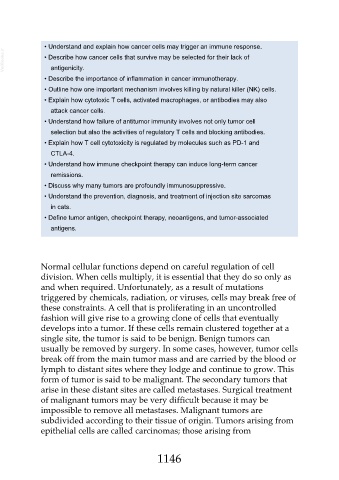Page 1146 - Veterinary Immunology, 10th Edition
P. 1146
• Understand and explain how cancer cells may trigger an immune response.
VetBooks.ir • Describe how cancer cells that survive may be selected for their lack of
antigenicity.
• Describe the importance of inflammation in cancer immunotherapy.
• Outline how one important mechanism involves killing by natural killer (NK) cells.
• Explain how cytotoxic T cells, activated macrophages, or antibodies may also
attack cancer cells.
• Understand how failure of antitumor immunity involves not only tumor cell
selection but also the activities of regulatory T cells and blocking antibodies.
• Explain how T cell cytotoxicity is regulated by molecules such as PD-1 and
CTLA-4.
• Understand how immune checkpoint therapy can induce long-term cancer
remissions.
• Discuss why many tumors are profoundly immunosuppressive.
• Understand the prevention, diagnosis, and treatment of injection site sarcomas
in cats.
• Define tumor antigen, checkpoint therapy, neoantigens, and tumor-associated
antigens.
Normal cellular functions depend on careful regulation of cell
division. When cells multiply, it is essential that they do so only as
and when required. Unfortunately, as a result of mutations
triggered by chemicals, radiation, or viruses, cells may break free of
these constraints. A cell that is proliferating in an uncontrolled
fashion will give rise to a growing clone of cells that eventually
develops into a tumor. If these cells remain clustered together at a
single site, the tumor is said to be benign. Benign tumors can
usually be removed by surgery. In some cases, however, tumor cells
break off from the main tumor mass and are carried by the blood or
lymph to distant sites where they lodge and continue to grow. This
form of tumor is said to be malignant. The secondary tumors that
arise in these distant sites are called metastases. Surgical treatment
of malignant tumors may be very difficult because it may be
impossible to remove all metastases. Malignant tumors are
subdivided according to their tissue of origin. Tumors arising from
epithelial cells are called carcinomas; those arising from
1146

